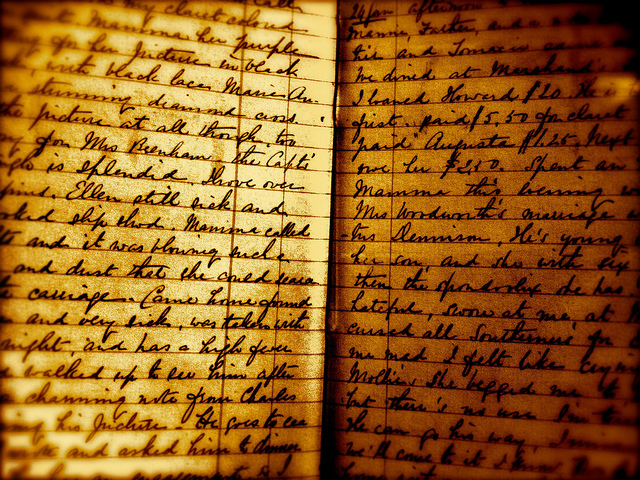On 1st January I started the ‘No Bro’ Challenge: a commitment to reading no straight white male authors for a whole year. “That’s impossible!” said one of my co-workers in the bookshop where I worked. “There aren’t enough authors to read!”
Another co-worker recommended the Scotland-set novel Sunset Song, whose author Lewis Grassic Gibbon (real name James Leslie Mitchell) was heterosexual, white and male. ‘But that doesn’t matter’, she said, the quality of the book should take precedence. ‘And the author’s invisible, isn’t it?’ Whether we accept Roland Barthes’ classic 1967 essay ‘The Death of the Author‘, that the author is divorced from the work once it reaches the audience, impacts strongly on how we view gender in reading and writing. Is there an inherent quality that defines it as the work of a male, female or neuter author? Or, to play on the ‘invisible’, are some authors literally hidden away because of their gender?
When the Telegraph published a list of ‘Best European and Russian novels of all time‘, the fifteen books included two female authors. Notably the list spans the seventeenth to the twentieth centuries, with the two women divided by three hundred years (Madame de Lafayette’s 1678 The Princess of Cleves and Simone De Beauvoir’s 1970 Coming of Age). The range in period and presence of late twentieth-century publications cut down any argument that women haven’t had time to join the classics. It suggests an ongoing sidelining of certain authors, based on their identity as female. The experience of non-white authors and readers is also a challenging one, the complexity of which cannot be properly discussed here.

What would a woman’s name tell us about her literary output? The ever-popular Joanne Kathleen Rowling has published both of her successful series under masculine or neutral pseudonyms, in the same tradition that Mary Ann Evans became George Eliot and the Bronte trio was transformed into the Bell brothers. In claiming another gender, or even no gender in Rowling’s case, the authors divorce their identity from their writing. Suggesting a relationship between the two is the groundwork of Helene Cixious’ écriture feminine, or “female writing”, described in her 1975 essay ‘The Laugh of the Medusa’. Cixious proposes that a woman’s use of language is born out of her gender and allows her to freely express herself in opposition to the male, existing in a thoroughly binary structure. A modern rival to Cixious’ theory is an author whose identity exists in name alone: Elena Ferrante.
Ferrante cannot be identified by age, location or anything beyond her voice: she is famously elusive and gives no interviews. However, her Neapolitan novels have achieved international success in their account of two women’s coming of age. The subject matter and presentation of the books (each showing a woman, in the company of either another woman or a man, seen from behind) indicates a focus on the experience and perspective of women – indeed, the covers not only place a woman at their centre, reflecting the novel’s focus point, but also show us the same view that she enjoys, pointing to the experience of seeing the narrative through her eyes.
Intriguingly, Ferrante’s anonymity has given rise to a theory that the books are actually produced by a male author, or even a collective. Jan Shilling suggested that Ferrante’s works are deliberately exploring the idea of an inherently “female voice” – indeed, Ferrante is quoted in a 2002 interview (not in person) as initially trying to write like a man: “It seemed to me that all the great writers were male”. In 2015 the author Catherine Nichols revealed that she’d submitted her latest manuscript under the name ‘George Leyer’, to a far better reception than she’d received under her own name. ‘George’ received 17 positive responses to his manuscript, netting eight and a half times the responses of Nichols for the same book. Both examples undermine the idea that an author’s identity is unavoidably expressed through their language, but the supposed link has bled thoroughly into modern publishing practice.
However, the category “women’s fiction” risks consuming all female authors, creating expectations of any woman’s work to fit a certain style, type of content and associations of lightness and frivolity
The relationship between gender and publication – the route to being published and the form in which the book appears – is a striking one. The genre of ‘women’s fiction’ can be found on Amazon and Goodreads, alongside science fiction, romance, horror. However, the category risks consuming all female authors, creating expectations of any woman’s work to fit a certain style, type of content and associations of lightness and frivolity. The Twitter ‘Coverflip’ campaign produced by Maureen Johnson, (Young Adult author) drew attention to the visual shorthand for women’s fiction, asking readers to reimagine a novel as though it were written by the opposite gender.
By segregating women into a genre, it becomes an effort to find and read them. Within the category of ‘female European writers’ I discovered Marie Ndiaye, whose novel 3 Femmes Puissantes, or ‘Three Strong Women’, won the Prix Goncourt in 2009. Once you find Ndiaye, you discover a celebrated writer. The novel in question is certainly grounded in her own web of identities – a half-French, half-Senegalese writer, whose identity is woven into her race and sense of place as well as gender. One can see a clear parallel in the three titular women’s journeys between France and Senegal. The cover of the 2012 Quercus edition shows a close-up of a black woman with a soft pastel background behind her. Doing so foregrounds the protagonists’ physical identity as women of colour, which affects them throughout the narrative (returning home from France to a Senegalese father, for example, or travelling the other way). I found Ndiaye’s book by specifically searching for female authors of colour based in Europe – without these criterion, I may never have found her. If one believes the book’s widespread praise, then why isn’t it prominently displayed?

How can a woman be published in today’s Europe? In 1991 the Baileys Women’s Prize for Fiction (previously the Orange Prize) was born, and is awarded annually to the best novel by a woman written in English. Though contested each year, primarily by male authors who feel dismissed by its isolated focus on women, it remains an institution, seeing winners from Angela Carter (the reason the prize was invented) to Chimamanda Ngozi Adichie. The examination of women in publishing is not limited to the writers: VIDA holds an annual Count of the number of works published by men and women in a range of papers, including a Count focused on women of colour to highlight the disparity caused by the intersection of both race and gender. The statistics for each publication are compared with the previous year, rendering their progress towards diversity absolutely explicit. Whether a writer moves towards a friendlier publication or puts pressure on a slower change is their choice, but the VIDA Count gives an insight into the publishing industry that forces the publishers’ choices into the open.
Finally, I propose that the key relationship in the publishing industry is that of author and reader – after the tortuous process of creating and refining the book, the author wishes to be heard, and the extra challenges for an author who isn’t white, male and heterosexual only underlines this desire to speak. The 2014 Salary Survey registers 51% of managerial positions in publishing being held by women, but the industry is driven by demand – a demand that it structures through making certain authors more prominent, but one that can be rewritten through the power of the reader. Try the No-Bro Challenge, or join in the raging literary conversation: who do you think Ferrante is?
Cover photo: Alan Trotter(Flickr); Licence: CC BY-NC-ND 2.0





